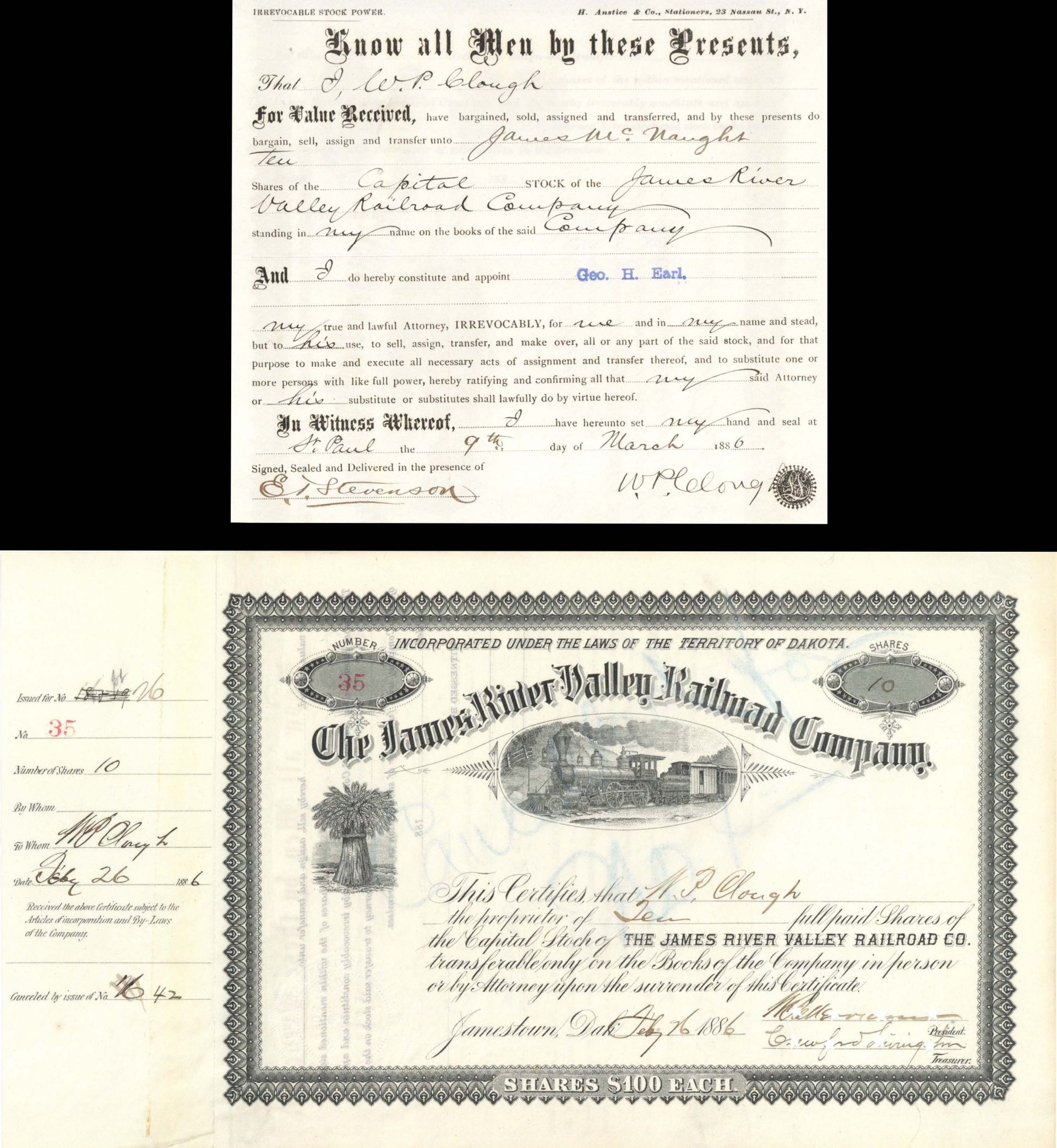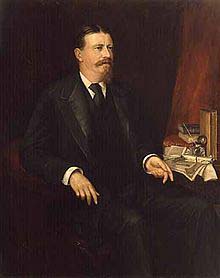James River Valley Railroad Co. signed by Clough, Merriam and Livingston
Inv# AG2101 Stock
Stock Issued to and signed by W.P. Clough. Also signed by W.R. Merriam as president and Crawford Livingston as treasurer.
William P. Clough, Chairman of the Board on the resignation of Howard Elliott as president and the creation of this new office. The creation of this office and the election of Mr. Clough to it are rather a concrete expression of the appreciation of the Northern Pacific directors for the responsiblility and executive work which Mr. Clough has been doing for the past 12 years than any radical change in these duties. William P. Clough was born in cortland County, New York and began railway work on October 1, 1880 as general cousel in the west for the Northern Pacific; occupying that position until June 1, 1887, when he entered the executive department of the St. Paul, Minneapolis and Manitoba as assistant to the president, soon after becoming a director and second vice-president of that company. February 1, 1890, when the St. Paul, Minneapolis and Manitoba was taken over by the Great Northern, he became a director of the latter company, and remained until the summer of 1901, when he resigned them to become a director of the Chicago, Burlington and Quincy, and a director and member of the executive committee of the Northern Pacific, which positions he has continued to hold, and which, for the past 12 years, have chiefly occupied his time. On July 1, 1912, he became the first vice-president of the Northern Pacific.

William Rush Merriam (July 26, 1849 – February 18, 1931) was an American politician. The son of Minnesota House Speaker John L. Merriam, he served in the Minnesota House of Representatives in 1883 and 1887 and was the Speaker of the House in 1887. He served as the 11th Governor of Minnesota from January 9, 1889 to January 4, 1893. He was a Republican.
By 1888 a split in the state Republican Party was reflected in an unorthodox selection of a gubernatorial candidate. Instead of supporting the reform-minded incumbent, Andrew Ryan McGill, a majority of party stalwarts rallied behind William Merriam, an ambitious St. Paul banker and speaker of the Minnesota House of Representatives.
Merriam's re-election campaign two years later was affected by another, more widespread phenomenon, the Farmers' Alliance. This third party of disaffected Republicans and Democrats was dedicated to promoting the commercial and social interests of agrarian America. Merriam defeated the Alliance candidate in 1890, but the upstart party significantly eroded his plurality.
As governor, Merriam was a thrifty executive who was more interested in limiting spending than in legislative reform. The most notable legacy of his administration was the adoption of the Australian ballot, which allowed citizens to vote in comparative privacy. In his private life, the sociable Merriam was keen on sports, owned horses, and was said to possess "good nature, gracious manners, and an attractive personality."
Merriam's final accomplishment was appropriate for a banker and businessman who could work well with both people and numbers. He was director of the twelfth national census and later persuaded Congress to establish a permanent Census Bureau, where he served as its first director. Merriam never returned to Minnesota, but retired instead to Florida, where he died in Port Sewall at age 81.
His three-quarter portrait by the Swiss born American artist Adolfo Müller-Ury (1862–1947) was painted in 1892. This and a portrait of his wife were exhibited in St. Paul in that year. A small, bust-length portrait, is now in the collection of the Newport Preservation Society, Rhode Island; it was formerly in the collections of Jessica Dragonette and the University of Wyoming. Müller-Ury is also known to have painted a portrait of their son Amherst Merriam as a baby.
Merriam is buried at Rock Creek Cemetery in Washington, DC.
Crawford Livingston, railroad builder, St. Paul, Minn., descends from the famous Livingston family, land owners of New York. Crawford was born in New York City May 6, 1848 and educated in the academy at Albany, and at the age of sixteen became a stock broker on Broad Street, New York City, in White, Livingston & Kendrick. He was afterward Deputy Treasurer of New Jersey. In 1870, he settled in St. Paul as purchasing agent of the Winona & St. Peter Railway and as stock broker and a banker. With Henry Villard he built The Little Falls & Dakota Railway and then built and owned The James River Valley Railway and The Detroit & Manitoba Railroad. He was also associated with A.B. Stickney in constructing The Minnesota Central and The Minnesota & North Western Railways, another of his road being The Chicago & Great Western. Livingston has been continuously successful in his operations, and had large interest outside the field of transportation, being controlling owner of The St. Paul Gas Light Co., and connected with The Merchants' National Bank, The Union Bank, The Title Insurance & Trust Co., The St. Paul Light, Heat & Power Co., The Edison Electric Co., The Inter-State Investment Co., The International Dock & Warehouse Co., The Livingston Land Co., and several other corporations. Mr. Livingston was married, Jan. 28, 1875 in St. Paul to Mary S. Livingston. His children were Crawford, Marie Steele, Abby Francis and Gerald Moncrieffe Livingston. He was president of the Town and Country clubs and a member of the St. Paul, Minnesota, Baptism River, Curling, St. Paul Driving and Island Pass clubs, and of the New York club of New York City.
A stock certificate is issued by businesses, usually companies. A stock is part of the permanent finance of a business. Normally, they are never repaid, and the investor can recover his/her money only by selling to another investor. Most stocks, or also called shares, earn dividends, at the business's discretion, depending on how well it has traded. A stockholder or shareholder is a part-owner of the business that issued the stock certificates.










Ebay ID: labarre_galleries